
Boletus edulis is a basidiomycete fungus, and the type species of the genus Boletus. Widely distributed in the Northern Hemisphere across Europe, Asia, and North America, it does not occur naturally in the Southern Hemisphere, although it has been introduced to southern Africa, Australia, New Zealand, and Brazil. Several closely related European mushrooms formerly thought to be varieties or forms of B. edulis have been shown using molecular phylogenetic analysis to be distinct species, and others previously classed as separate species are conspecific with this species. The western North American species commonly known as the California king bolete is a large, darker-coloured variant first formally identified in 2007.

The China men's national basketball team represents the People's Republic of China in international basketball tournaments. The national team is governed by the Chinese Basketball Association (CBA). Based on the number of tournament titles, China is considered a major basketball powerhouse in Asia and has by far the most successful basketball program on the continent.
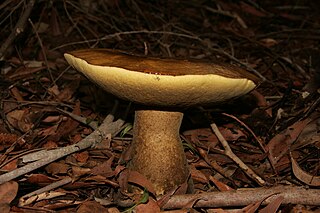
Phlebopus marginatus, commonly known as the salmon gum mushroom in Western Australia, is a member of the Boletales or pored fungi. An imposing sight in forests of south-eastern and south-western Australia, it is possibly Australia's largest terrestrial mushroom, with the weight of one specimen from Victoria recorded at 29 kg (64 lb). Initially described in 1845 as Boletus marginatus, and also previously known by scientific names such as Phaeogyroporus portentosus and Boletus portentosus, it is not as closely related to typical boletes as previously thought.

Xerocomus is a genus of poroid fungi related to Boletus. Many mycologists did not originally recognize the distinction between the two genera and placed Xerocomus taxa in genus Boletus. However, several molecular phylogenetic studies have demonstrated that Xerocomus is a heterogeneous genus of polyphyletic origin, which has resulted in further division of Xerocomus into Xerocomellus and Hemileccinum. The members of the genus Xerocomellus are more closely related to Boletus than true Xerocomus is, which is relatively distantly related to Boletus and more closely related to Phylloporus. Other former Xerocomus species have since been moved to Aureoboletus, Imleria, Hortiboletus and Rheubarbariboletus.

Boletellus is a genus of fungi in the family Boletaceae. The genus has a widespread distribution, especially in subtropical regions, and contains about 50 species. The genus was first described by American mycologist William Alphonso Murrill in 1909. The genus name means "small Boletus".

Boletellus obscurecoccineus, known as the rhubarb bolete, is a species of fungus in the family Boletaceae, found in Australia, New Guinea, Java, Borneo, Japan, Korea, and Taiwan. It is a distinctive and colourful bolete of the forest floor.

Aureoboletus mirabilis, commonly known as the admirable bolete, the bragger's bolete, and the velvet top, is an edible species of fungus in the Boletaceae mushroom family. The fruit body has several characteristics with which it may be identified: a dark reddish-brown cap; yellow to greenish-yellow pores on the undersurface of the cap; and a reddish-brown stem with long narrow reticulations. Aureoboletus mirabilis is found in coniferous forests along the Pacific Coast of North America, and in Asia. Unusual for boletes, A. mirabilis sometimes appears to fruit on the wood or woody debris of Hemlock, suggesting a saprobic lifestyle. Despite occasional appearances to the contrary, Aureoboletus mirabilis is mycorrhizal, and forms close mutualistic associations with hemlock roots.

Tylopilus plumbeoviolaceus, commonly known as the violet-grey bolete, is a fungus of the bolete family. First described in 1936, the mushroom has a disjunct distribution, and is distributed in eastern North America and Korea. The fruit bodies of the fungus are violet when young, but fade into a chocolate brown color when mature. They are solid and relatively large—cap diameter up to 15 cm (5.9 in), with a white pore surface that later turns pink, and a white mycelium at the base of the stem. The mushroom is inedible. A number of natural products have been identified from the fruit bodies, including unique chemical derivatives of ergosterol, a fungal sterol.
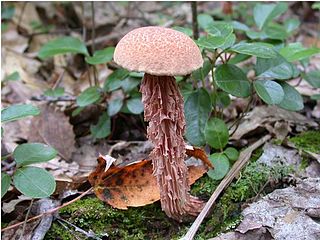
Aureoboletus russellii, commonly known as Russell's bolete, is a species of bolete fungus in the family Boletaceae. An edible species, it is found in Asia and eastern North America, where it grows in a mycorrhizal association with oak, hemlock, and pine trees. Fruit bodies of the fungus are characterized by their coarsely shaggy stem. The yellow-brown to reddish-brown caps are initially velvety, but become cracked into patches with age.

Aureoboletus auriflammeus, commonly known as the flaming gold bolete, is a species of bolete fungus in the family Boletaceae. Described as new to science in 1872, it is found in eastern North America, where it grows in a mycorrhizal association with oaks. The caps of the fruit bodies are golden orange, with a yellow pore surface on the underside, and a reticulated (network-like) stem. The edibility of the mushroom is not known.
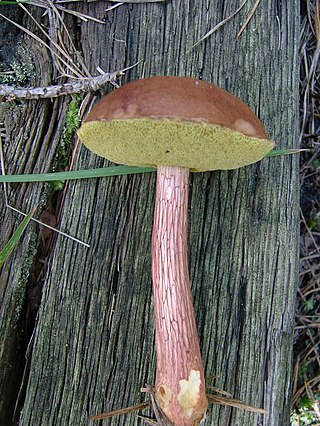
Aureoboletus projectellus is a species of bolete fungus in the family Boletaceae. Found in North America, and recently in Europe, it grows in a mycorrhizal association with pine trees.
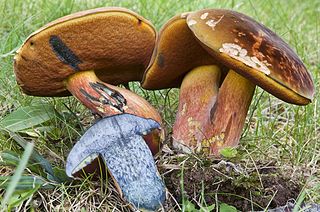
Boletus subvelutipes, commonly known as the red-mouth bolete, is a bolete fungus in the family Boletaceae. It is found in Asia and North America, where it fruits on the ground in a mycorrhizal association with both deciduous and coniferous trees. Its fruit bodies (mushrooms) have a brown to reddish-brown cap, bright yellow cap flesh, and a stem covered by furfuraceous to punctate ornamentation and dark red hairs at the base. Its flesh instantly stains blue when cut, but slowly fades to white. The fruit bodies are poisonous, and produce symptoms of gastrointestinal distress if consumed.
The Legend of Crazy Monk is a Chinese television series about the life of Ji Gong. The series was directed by Lin Tianyi and based on Guo Xiaoting's classical novel Biography of Ji Gong. It was a hot TV series recently in Guangdong Television, Jiangsu Television and Shenzhen Television. It is shown on Mediacorp Channel 8 at 7pm.
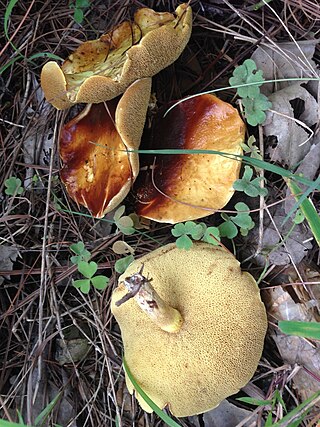
Suillus kunmingensis is a species of bolete fungus in the family Suillaceae. It was described as new to science in 1948 by Wei-Fan Chiu as a species of Boletinus; Wang and Yao transferred it to the genus Suillus in a 2004 nomenclatural revision of several Chinese boletes. The species epithet alludes to the type locality—Kunming, China—where the first scientific collections of the bolete were made in November, 1941. It has also been recorded from Sichuan. Similar Suillus species include S. pinetorum and S. punctatipes.
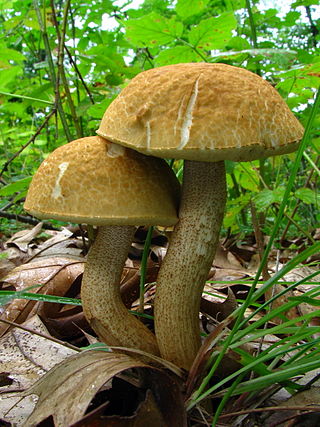
Leccinellum rugosiceps, commonly known as the wrinkled Leccinum, is a species of bolete fungus. It is found in Asia, North America, Central America, and South America, where it grows in an ectomycorrhizal association with oak. Fruitbodies have convex, yellowish caps up to 15 cm (5.9 in) in diameter. In age, the cap surface becomes wrinkled, often revealing white cracks. The stipe is up to 10 cm (3.9 in) long and 3 cm (1.2 in) wide, with brown scabers on an underlying yellowish surface. It has firm flesh that stains initially pinkish to reddish and then to grayish or blackish when injured. The pore surface on the cap underside is yellowish. Fruitbodies are edible, although opinions vary as to their desirability.

Mu Zang was a Chinese mycologist. He was known for his research on the Boletales of China, and the ecology and biogeography of fungi in southwestern China. He described more than 140 new species and circumscribed three genera, published more than 150 research papers, was chief editor or co-editor for twelve books, and wrote two monographs on the Boletaceae of China. His final book, "Dictionary of the Families and Genera of Chinese Cryptogamic (Spore) Plants" was co-authored with his wife, Professor Xinjiang Li.
Aureoboletus zangii is a species of bolete fungus in the family Boletaceae. It is found in Shaanxi, China, where it grows on the ground in broad-leaved mixed forests dominated by Cyclobalanopsis and Quercus. Fruitbodies are characterized in the field by the yellow-brown to reddish-golden colours, and sticky cap and stipe. Similar species include the Asian species A. thibetanus and the European A. gentilis.
Tricholoma zangii is a mushroom of the agaric genus Tricholoma. The species was originally described by mycologist Mu Zang in 1990, who called it Tricholoma quercicola. It was later discovered that this name was a later homonym of a North American species described by William Alphonso Murrill in 1949, and a new name was needed.
Boletus gansuensis is a species of bolete fungus in the family Boletaceae. Found in China, where it grows in association with Himalayan birch, it was described as new to science in 2003. The fruitbodies of the fungus have red caps, pinkish-red pores on the cap underside, and a somewhat furfuraceous stipe. The specific epithet refers to the type locality in Gansu Province, China. Similar species include the European Suillellus queletii, and the North American and Asian Boletus subvelutipes.
The Chinese orangutan is an extinct species of orangutan from the Pleistocene of South China. It is known from fossil teeth found in the Sanhe Cave, and Baikong, Juyuan and Queque Caves in Chongzuo, Guangxi. Its dental dimensions are 20% bigger than those of living orangutans. The youngest remains of the species date to between 57,000-66,000 years ago in Yincun Cave, Guangxi.















